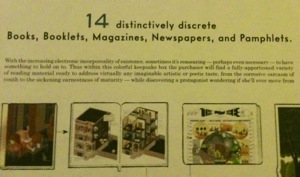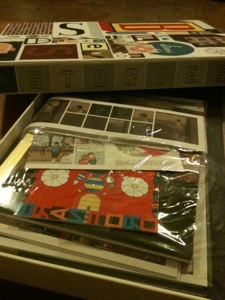
Thrilled today to get Building Stories, Chris Ware’s latest.
Thrilled here is no hyperbole—I can’t remember being so excited to open a book in quite some time.
But Building Stories isn’t really a book.
First, it comes in this big box—like a board game.
Here:

I show it set against The Catcher in the Rye in mass market paperback and a glass of red.
(The Catcher in the Rye + glass of red is the international standard for items used to show relative dimensions of size).
(Also, don’t worry about the wine ring—still shrinkwrapped at this point).
And on that shrinkwrap blazons a blurb by some guy named J.J. Abrams:

A description of the formal elements of Building Stories from the back of the box:

I open the box:

From the inside of the top of the box:
Not sure if that second quote shows here, but:
Pablo Picasso suggests that, Everything you can imagine is real.

The package:

Strips and papers and books.
Shots as I go through it:

Stack: The shorter/smaller stuff is on top—a suggestion to read it first? / Probably not.
Probably more a packing issue.

I remember a professor in grad school musing about where a book begins.
The title page?
The cover?

How and where does a book begin?

Chris Ware’s Building Stories: a kind of Möbius strip,

crammed with ideas,

illustrations,

writing,

stories . . .

Little golden book

. . . and broadside.

. . . so many faces . . .

. . . layers . . .

. . . and layers . . .

Ware’s transitions:

(They always remind me of David Foster Wallace, who I know Ware read).

And thus so well . . .

Disconnect?

Boom!

I should’ve busted out the wine glass or the Salinger here to show the scale of this marvelous painting, better than anything I’ve seen in contemporary art in ages. It tells all the story. (Wait, you (maybe) say, have you actually read the story yet?)

No.
But who hasn’t felt:

And

Thus

So

Well . . .

[Insert ideas about malleability of form, sequence, narrative, idea—riff on discursive-novel-as-future-novel, etc.]
End riff/now look, read, absorb.

I know I’m going to get shit for saying this, but I would need real solid, legal-type evidence to even make me begin to reconsider what I’m about to say: Chris Ware is the best fiction writer in America. He outs all the heavy-hitting Capital “A” American novelists working today (the usual suspects: Eugenides, Franzen, Chabon, Lethem) as the stale, middlebrow pellet-pushers they are. Ware’s last Acme (the one about the dude stranded on the moon) was the best piece of sci-fi I have read in a long time. Ware is funny, has lots of heart, a pitch-black sense of what it means to be human, and is formally, well, I don’t think I need to explain his formalist bonafides. I think people tend to overlook his words because of the jaw-dropping beauty of his art, but his dialogue and interior monologues rival anything that anyone is doing right now. Give me one Ware thought-bubble over Chabon’s 12-page sentence any day. Plus, I like how Ware is unadabtable to any other medium. That means a lot to me, especially when the above-mentioned writers seem to write with a bulging eye towards the big and little screen. I read a novel like The Art of Fielding, and I swear to God, I have no idea, save for a few rhetorical flourishes, what the difference is between that book and a screenplay or any other type of tele-visual treatment. God Bless You, Chris Ware. As soon as I stop spending all of my extra play-cash on Barbie dolls for my daughters I will buy this book and devour it whole in one sitting.
LikeLike
Well you won’t get shit from me, that’s for sure, especially lining him up against the list of usual suspects. (I am still smarting from the vitriol spit at me on the AV Club comment board for dissing Chabon—dude has some major fanboys). Building Stories is clearly attempting something that hasn’t been done before—sure, McSweeney’s and others have put out similar “issues” or “collections,” but the hours I spent with this last night suggest something else entirely—something cohesive but fragmentary, aesthetically unified but a challenge to stability, etc. As far as the price—I see it listed on Amazon for $30 now, which is not too bad at all considering how beautiful and strange it is. (It also weighs like 10 pounds).
LikeLike
Good point about mainstream novelists not really exploring the potential of the medium they’re working in. I guess it has become difficult to actually produce a bestselling “big” novel (that has been conceived as such) that plays with the book form because it’s expected to affect readers equally as well on e-readers, which have their own mediality but one very different from books-in-pages. It’s like being in limbo between the two and not being able to use either medium. You end up with a sort of “pure” text, which is easy to adapt to film because there is hardly any remnant of bookness to it anymore. These novels are no longer bound by their medium. Which could be a good thing, it certainly suggests a kind of freedom, but I think it’s also a definite empoverishment. Maybe Mark Z. Danielewski is the closest equivalent on the novel side to comics’ Chris Ware? But then, he seems to no longer be producing books in the stricter sense anymore, either. I guess the question is: What is the medium best suited for writing today? It used to be tablets, scrolls, books; now it’s screens mostly. But probably until there’s a definite answer, there will always be an identity crisis of sorts for the novel. Filmic writing seems to be the most popular answer to that dilemma.
Anyway, if you’re wondering about form as it pertains to writing, be sure to check out Anne Carson’s Nox. Another big physical box, but different still from Ware or Danielewski.
LikeLike
I could never get into Danielewski’s book, but I’ll seek the Nox for sure.
I read on a tablet (Kindle Fire) as much as I read physical books these days (actually, I almost assuredly read more screen than print these days, not counting the student work I have to assess and comment on for a living)—I’m talking the stuff I read on my laptop and iPhone, in addition to the Kindle.
I think that Ware’s book is the best case I’ve seen in a while for physical books—and I’ve seen some good cases lately (including Giulio Tononi’s Phi and Paglia’s Glittering images). What these books share in common is a respect for the physical form, but none of them even get close to what Ware’s done here, which made my five year old—who, despite my protest, wants to be “an artist”—flip out. I mean, she went nuts over it, and although that had little to do with the narrative content (which is obv not for kids), it still showed how strange and fun and intriguing Ware’s format is here—without being gimmicky.
I’ve been reading it piecemeal (there is no other way, of course!) — so I’d like to append: it’s great stuff.
LikeLike
End with Disconnect, you won’t regret it.
LikeLike
[…] collection Building Stories comprises fourteen comics of different shapes, sizes, and formats. I wrote about opening the box a few days ago, and I’ll (try to) write about reading each of the […]
LikeLike
[…] thing that got in the way of me reading it immediately was that it showed up in a package along with Chris Ware’s Building Stories (this is, without question, the best package I’ve received in six years of doing the […]
LikeLike
[…] 23rd, 2000 is one of the longer pieces in Chris Ware’s box set, Building Stories. Part of the joy and frustration of Building Stories is its free form—the […]
LikeLike